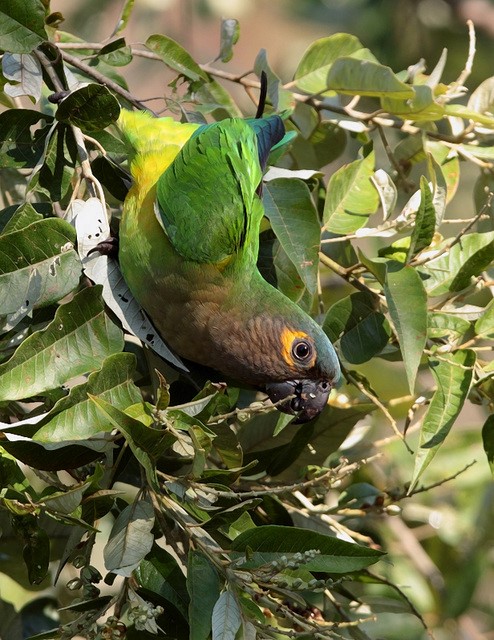Birdfinding.info ⇒ The widespread “typical” form of Brown-throated Parakeet is common in several areas: Aruba, northern Venezuela, the Llanos, and the savannas of Roraima and Guyana. It can often be found in urban parks of Caracas such as Los Caobos and del Este, and on Aruba at frequently visited sites such as Bubali Bird Sanctuary and Spaans Lagoon. In Colombia it is common in the Llanos, including the towns of Granada, Puerto Gaitán, and Villavicêncio. In the Guianas, it is generally common in the coastal lowlands, including cities such as Georgetown, Paramaribo, Kourou, and Cayenne. In Brazil it is common only in Roraima, including the capital, Boa Vista. (For the Dutch Antillean, Central American, and Colombian forms, see “Yellow-headed Parakeet”, “Veraguan Parakeet”, and “Gray-throated Parakeet”.)
Brown-throated Parakeet
Eupsittula pertinax
Northern South America, southern Central America, and southern Caribbean islands, where it occurs in mainly in semiopen habitats: scrub, savanna, open woodland, dry forest, and agricultural areas.
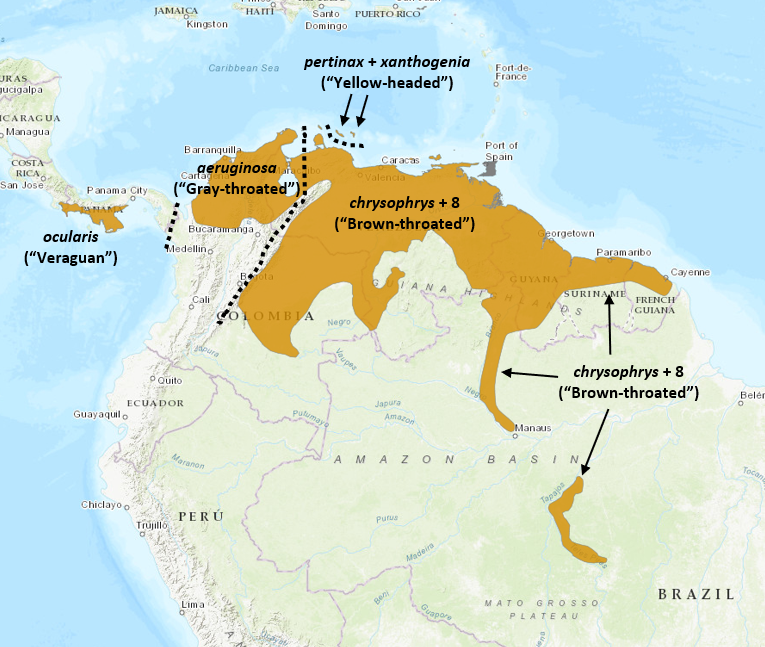
Approximate distribution of the four forms of Brown-throated Parakeet recognized here. © BirdLife International 2018
Includes four distinct forms, which may be best regarded as multiple species (see Distinguishing Features: Has the Diversity of Brown-throated Parakeets Been Overlooked?):
“Yellow-headed Parakeet” (pertinax and xanthogenia): of Curaçao and Bonaire.
“Gray-throated Parakeet” (aeruginosa—and griseipecta if valid): of northern Colombia and westernmost Venezuela.
“Veraguan Parakeet” (ocularis): of Panama and Costa Rica.
“Brown-throated Parakeet” (chrysophrys plus eight others): the widespread form consists of nine recognized subspecies spread across northern South America and some adjacent Caribbean islands—this form is discussed in detail below.
On the South American continent, it occurs in coastal lowlands and foothills from northwestern Venezuela (Falcón and Lara) east to French Guiana, and inland throughout the Llanos and the savannas of Roraima and western Guyana.
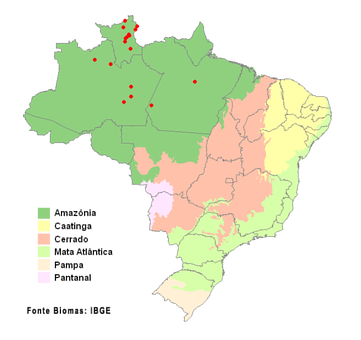
Brazilian records of Brown-throated Parakeet, by municipality. © WikiAves 2021
Farther south, it has been found at scattered sites in the Río Negro drainage from easternmost Colombia and adjacent Venezuela south and east into Brazil, along the main stem of the Amazon River, and farther south in eastern Amazonas and southwestern Pará.
In the Caribbean, there are distinct resident populations on Aruba and the Venezuelan islands La Tortuga and Margarita (in addition to the “Yellow-headed” populations on Curaçao and Bonaire).
A small population on Trinidad was first recorded in the 1980s and has persisted in low numbers, mainly in the Aripo savannas and nearby farmland. The origin of this population is unknown: although originally suspected of human-assisted arrival, it may represent natural colonization.
Identification
As their name suggests, all Brown-throated Parakeets have some amount of brownish coloration on or near the throat. Otherwise, the colors and pattern on the head are highly variable among the four distinct forms recognized here.
The three localized divergent forms (each potentially separate species) are discussed briefly below and in more detail on separate pages: “Yellow-headed” of Curaçao and Bonaire; “Gray-throated” of Colombia and western Venezuela; and “Veraguan” of Panama and Costa Rica.
The widespread, typical “Brown-throated” form also varies geographically, with some populations more brightly colored than average, and some duller.
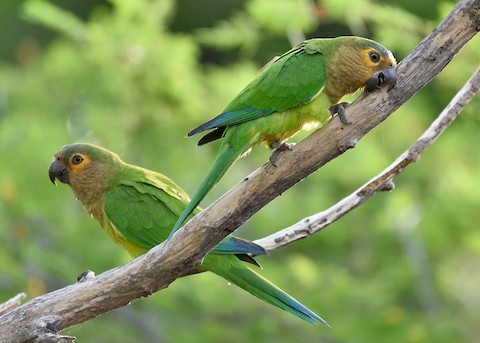
Brown-throated Parakeet, E. p. arubensis, pair, showing typical coloration—intermediate enough to occur in most, if not all, “Brown-throated” populations. (Moko, Aruba; October 20, 2020.) © Michiel Oversteegen
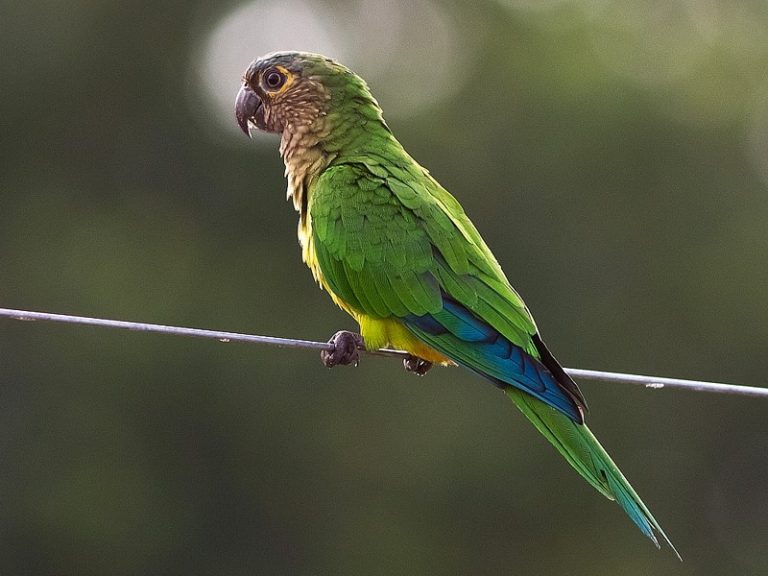
Brown-throated Parakeet, E. p. chrysophrys, showing typical coloration—intermediate enough to occur in most, if not all, “Brown-throated” populations. (Cantá, Roraima, Brazil; March 20, 2013.) © Marcelo Camacho
In typical adult plumage across most of the range, the face is largely ashy or olive-brown, like the throat, with some orange around the eye, usually a complete orange spectacle, and the forecrown typically shows a subtle bluish wash.
Otherwise mostly grass-green above and pale yellowish-green below—often with an orange or reddish wash on the belly. The flight feathers are extensively blue in varying shades, from aqua to royal blue.

Brown-throated Parakeet, E. p. surinama, pair, with orange eyerings that extend down onto the cheeks. (Aripo Livestock Research Station, Tunapuna-Piarco, Trinidad; November 19, 2015.) © Patsy Russo
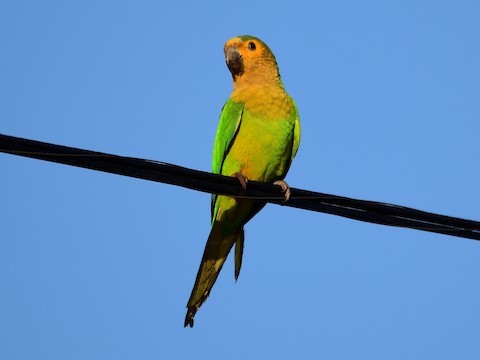
Brown-throated Parakeet, E. p. arubensis, with a wide orange eyering, orange forehead, and an orange tinge on the normally brown feathers of the face, throat, and chest. (Bubali Bird Sanctuary, Aruba; February 22, 2020.) © Michael Tromp
Certain populations (notably arubensis of Aruba, paraensis of Amazonian Brazil, and surinama of Trinidad, eastern Venezuela, and the Guianas—see above) tend to show more vivid and extensive orange, extending from the eyerings onto the cheeks and lores.
Certain other populations (notably lehmanni of the Llanos, venezuelae of northern and central Venezuela, and margaritensis of Isla Margarita—see below) tend to appear dingier and show a yellowish grayish-orange spectacle.
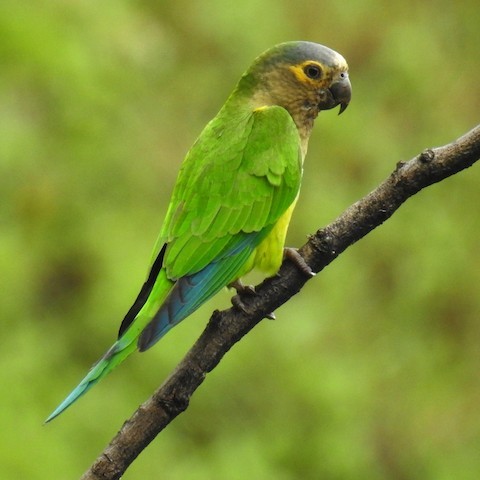
Brown-throated Parakeet, E. p. venezuelae, showing brown throat and dull yellowish eyering. (El Ávila National Park, Miranda, Venezuela; September 14, 2019.) © Fernando Nunes

Brown-throated Parakeet, E. p. venezuelae, pair, showing brown throat and dull yellowish eyering. (El Ávila National Park, Miranda, Venezuela; February 21, 2021.) © Fernando Nunes
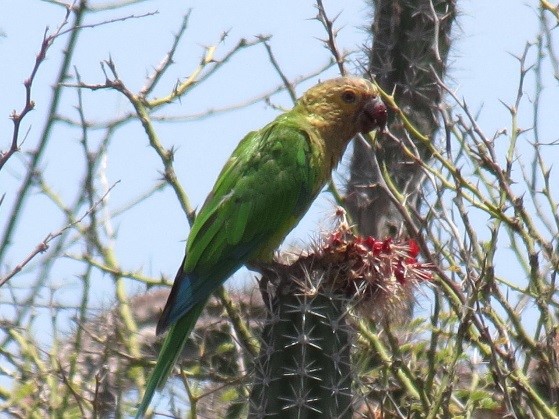
Brown-throated Parakeet, E. p. margaritensis, showing mostly grayish-brown head with vaguely orangish spectacles. (Macanao Peninsula, Isla Margarita, Venezuela; September 5, 2013.) © Thore Noernberg

Brown-throated Parakeet, E. p. chrysophrys, likely subadult with dull-orange spectacle and pale forehead. (Boa Vista, Roraima, Brazil; December 27, 2015.) © Marcelo Camacho
Immature Brown-throated are mostly green with olive face, throat, and chest, and a bold whitish or grayish eyering. As they mature, the olive turns more grayish-brown overall and yellowish or orange around the eyes.

Brown-throated Parakeet, E. p. chrysophrys, immature showing olive-brown face, throat, and chest, and bold whitish eyering. (Boa Vista, Roraima, Brazil; January 22, 2019.) © Roseanne Almeida

Brown-throated Parakeet, E. p. chrysophrys, older immature with grayish-brown face, throat, and chest—compare with geographically distant “Gray-throated Parakeet”, below. (Boa Vista, Roraima, Brazil; March 8, 2018.) © Silvia Faustino Linhares
“Gray-throated Parakeet”. The subspecies aeruginosa of central and northern Colombia and northwestern Venezuela (and introduced to Isla San Andrés) has no orange on its face and usually shows a distinctly blue forecrown.
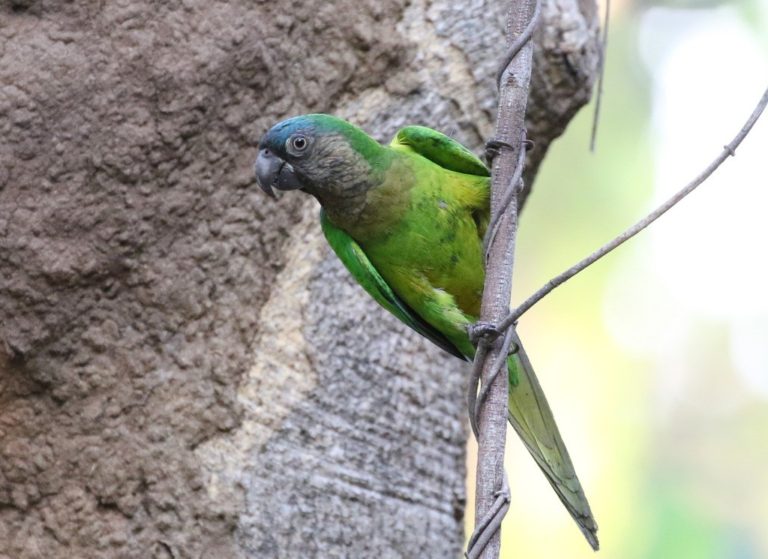
“Gray-throated Parakeet”, E. p. aeruginosa, showing typically gray throat, narrow grayish eyering, and blue forecrown. (La Elisa, Magdalena, Colombia; January 25, 2020.) © Matthew Grube

“Gray-throated Parakeet”, E. p. aeruginosa, showing typically gray throat, broad whitish eyering, and blue forecrown. (Taganga, Magdalena, Colombia; January 24, 2019.) © Graham Sorenson
Similar to the immatures of other Brown-throated populations, adult “Gray-throated” lack orange on the face. Instead, their eyerings are either whitish, grayish or powder-blue.
Confusion is likely because the eyerings of all Brown-throated subspecies begin whitish, then show color as they age.
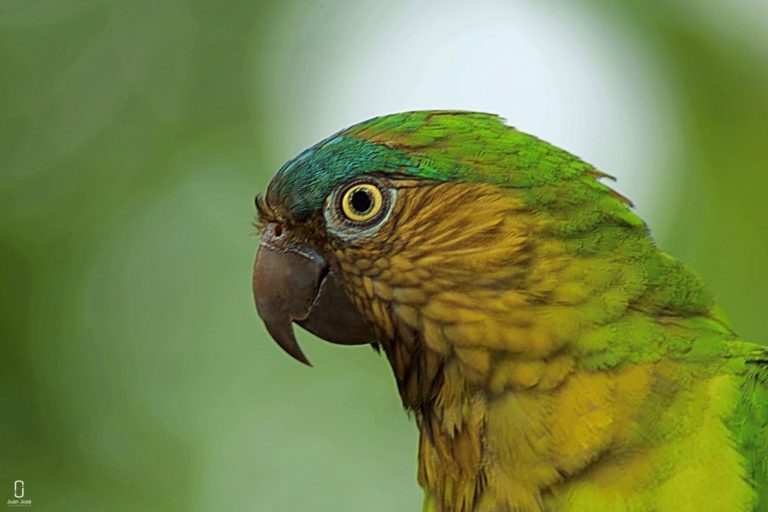
“Gray-throated Parakeet”, E. p. aeruginosa, showing atypically vivid coloration, including olive or yellowish brown face, throat, and chest, pale-bluish eyering, and turquoise crown. (Santa Cruz de Lorica, Córdoba, Colombia; May 7, 2018.) © Juan José López Negrete

“Gray-throated Parakeet”, E. p. aeruginosa, with a pale grayish face and forehead—possibly an immature. (Santuario de Fauna y Flora Los Flamencos, La Guajira, Colombia; July 30, 2017.) © Eric VanderWerf
The “Gray-throated” population in the Río Sinú drainage has been classified as separate subspecies, griseipecta, based in part on the distinction of having a pale-gray forehead—but pale-gray foreheads seem typical of immatures of “Gray-throated” and “Brown-throated” populations.
“Veraguan Parakeet”. The subspecies ocularis of southwestern Costa Rica and western and central Panama resembles the typical “Brown-throated” overall, but has an orange crescent under the eye instead of a complete eyering.
On some individuals the orange crescent extends farther onto the cheek. A similar pattern occurs in the most distant “Brown-throated” populations of the Guianas (surinama) and Amazonian Brazil (paraensis).

“Veraguan Parakeet”, E. p. ocularis. (Las Pangas, Puntarenas, Costa Rica; April 5, 2020.) © Daniel Hernández
“Yellow-headed Parakeet”. The subspecies pertinax of Curaçao (and introduced to St. John and Saba) and xanthogenia of Bonaire have extensive yellow or orange on their heads—and are thus strikingly different from other Brown-throated Parakeets.
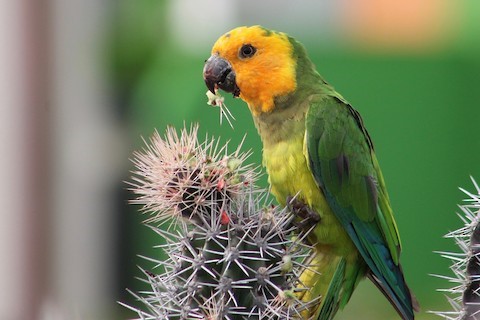
“Yellow-headed Parakeet”, E. p. xanthogenia. (Hato, Bonaire; October 3, 2018.) © Holly Kleindienst
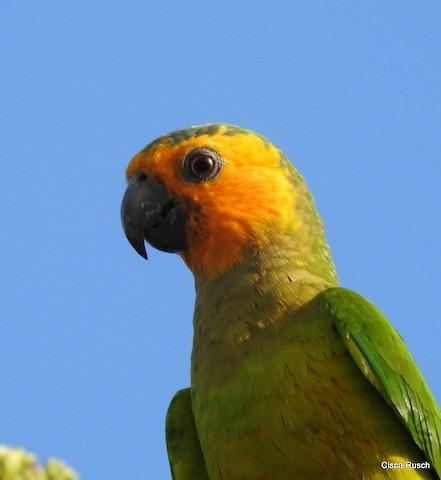
“Yellow-headed Parakeet”, E. p. pertinax. (Bullenbaai, Curaçao; January 18, 2020.) © Cisca Rusch
The Curaçao population usually (or always) has a noticeably green crown and nape. The Bonaire population may sometimes have an entirely yellow or orange head, including most of the crown. However, many Bonaire birds have green crowns and are probably indistinguishable from Curaçao birds.
Voice. Most typical calls are grating, mechanical-sounding screeches, sometimes shrill and sometimes lower and mellower:
Notes
Polytypic species consisting of fourteen recognized subspecies, provisionally divided here into four distinct forms—two of which apparently have not previously been recognized as distinct:
“Yellow-headed Parakeet” (pertinax and xanthogenia) of Curaçao and Bonaire.
“Gray-throated Parakeet” (aeruginosa— and griseipecta, if valid) of northern and central Colombia and the Maracaibo Basin of Venezuela.
“Veraguan Parakeet” (ocularis) of the Pacific slope of Central America from southern Costa Rica to central Panama.
“Brown-throated Parakeet” (chrysophrys, lehmanni, arubensis, tortugensis, margaritensis, venezuelae, surinama, chrysogenys, and paraensis)
For a discussion of the taxonomy of Brown-throated Parakeets, see Distinguishing Features: Has the Diversity of Brown-throated Parakeets Been Overlooked?
Additional Photos of “Brown-throated Parakeet”

Brown-throated Parakeet, E. p. arubensis. (Moko, Aruba; October 20, 2020.) © Michiel Oversteegen
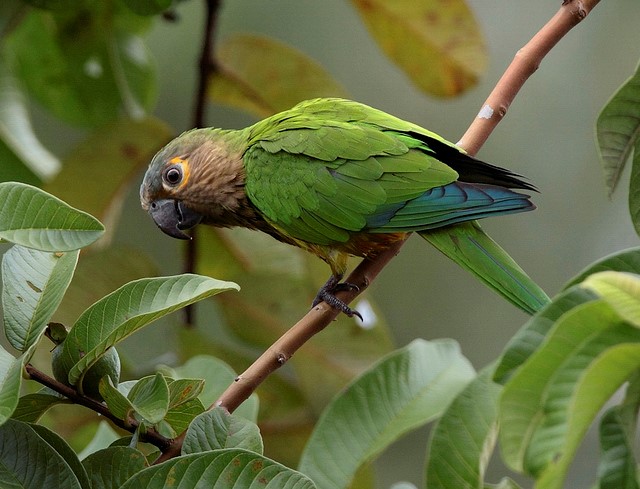
Brown-throated Parakeet, E. p. chrysophrys, showing a broken eyering with an orange crescent under the eye, approximately the same facial pattern as the “Veraguan Parakeet”, ocularis, of Central America. (Boa Vista, Roraima, Brazil; July 30, 2012.) © Anselmo d’Affonseca
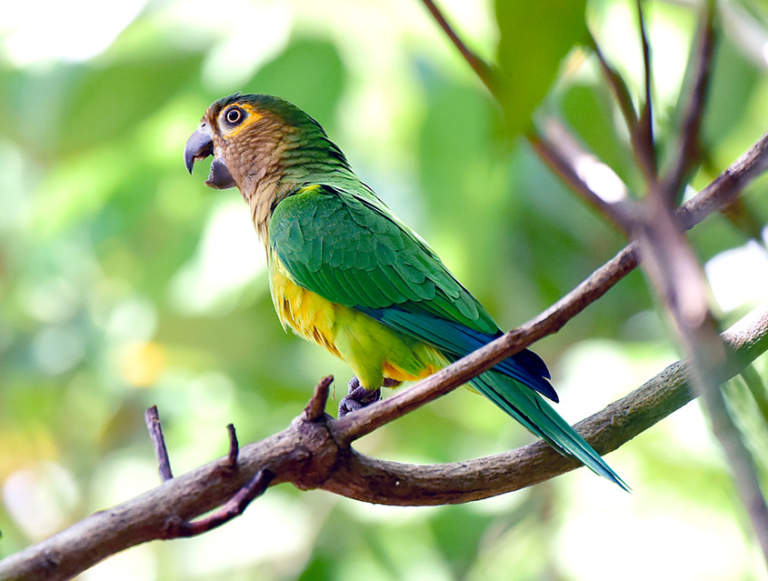
Brown-throated Parakeet, E. p. chrysophrys, with an exceptionally bold spectacle—also note orange tones on the belly. (Boa Vista, Roraima, Brazil; June 3, 2018.) © Jorge Macêdo

Brown-throated Parakeet, E. p. chrysophrys. (Cantá, Roraima, Brazil; June 6, 2018.) © Jorge D. Pavani
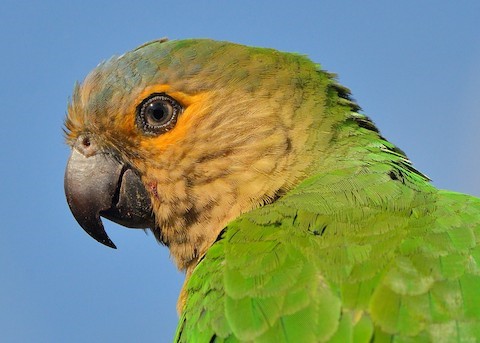
Brown-throated Parakeet, E. p. arubensis, facial close-up showing subtle distinction between pale-brown and orange feathering. (Bubali Bird Sanctuary, Aruba; August 9, 2019.) © Michiel Oversteegen
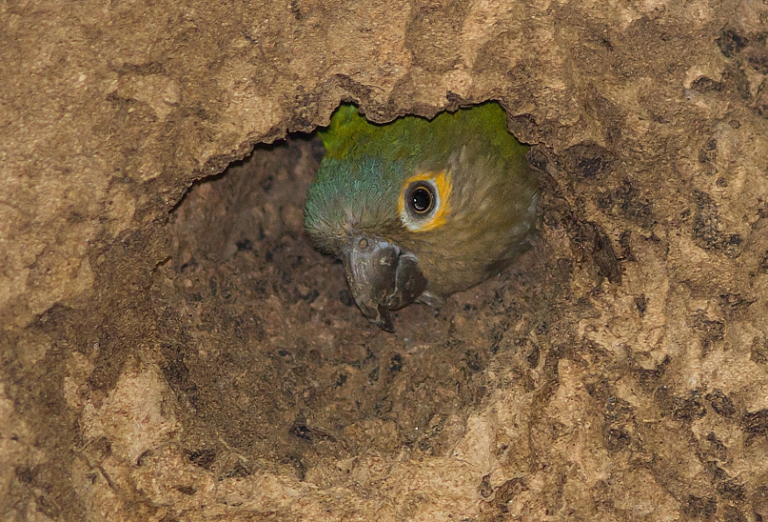
Brown-throated Parakeet, E. p. chrysophrys, peering out from the nest cavity. (Boa Vista, Roraima, Brazil; May 11, 2014.) © Marcelo Camacho

Brown-throated Parakeet, E. p. arubensis. (Bubali Bird Sanctuary, Aruba; February 4, 2014.) © Steven Mlodinow
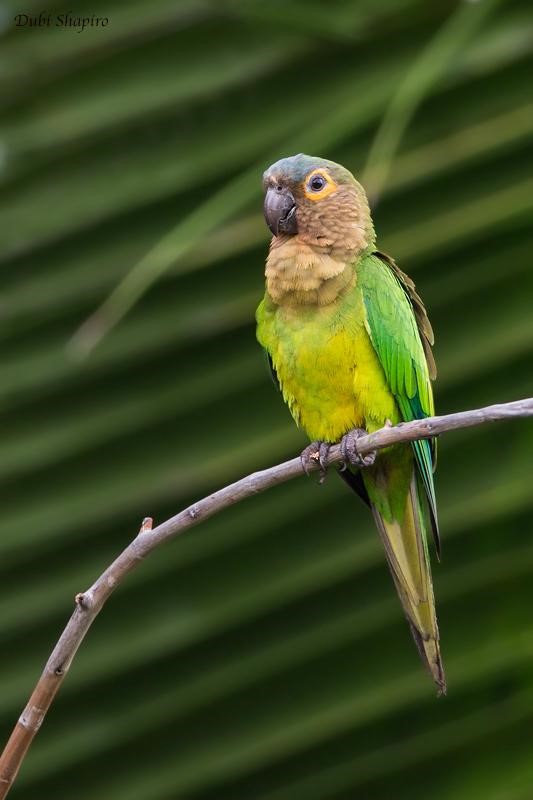
Brown-throated Parakeet, E. p. chrysophrys. (Surama Eco-Lodge, Guyana; November 17, 2016.) © Dubi Shapiro

Brown-throated Parakeet, E. p. chrysophrys, immature. (Boa Vista, Roraima, Brazil; March 11, 2020.) © Geraldo Luiz

Brown-throated Parakeet, E. p. venezuelae, immature. (El Ávila National Park, Miranda, Venezuela; July 23, 2021.) © Fernando Nunes
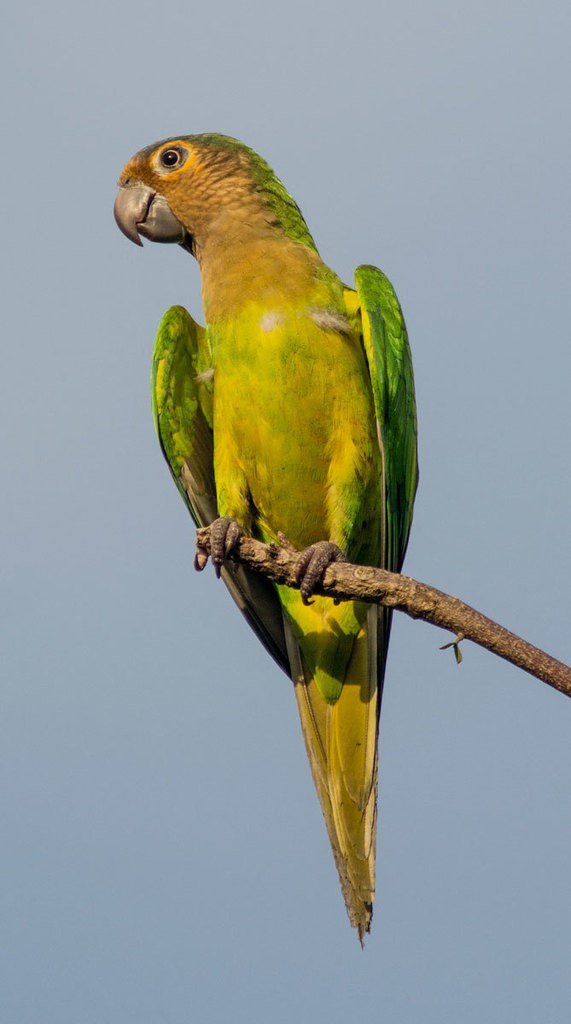
Brown-throated Parakeet, E. p. lehmanni, likely subadult. (Puerto López, Meta, Colombia; October 23, 2016.) © Juan Manuel Cardona Granda
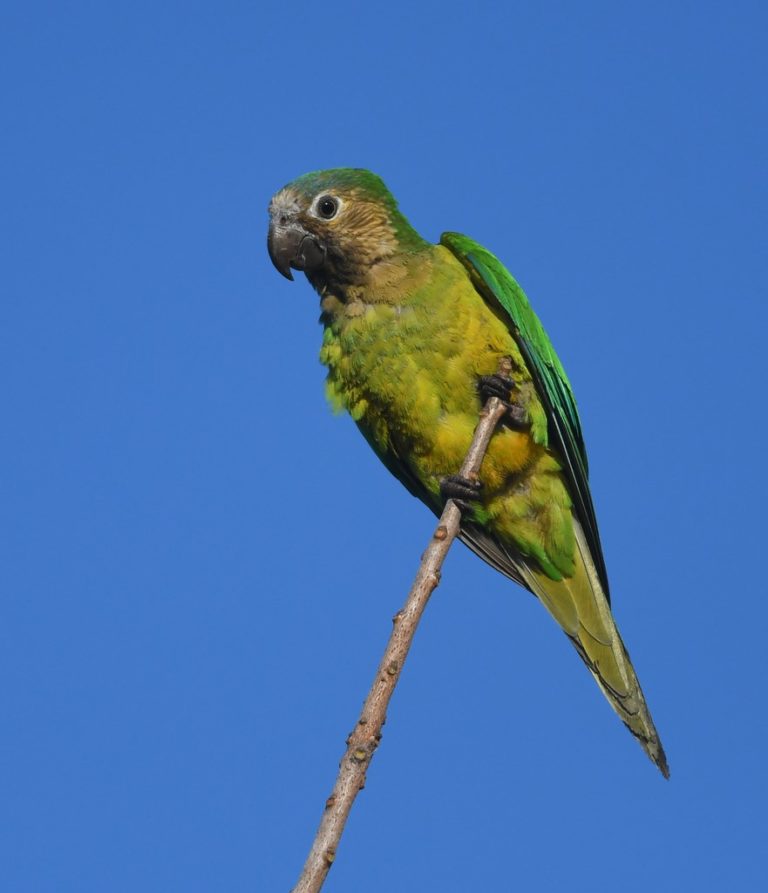
Brown-throated Parakeet, E. p. lehmanni, immature with pale-gray forehead. (Puerto López, Meta, Colombia; January 10, 2020.) © Joshua D. Vandermeulen

Brown-throated Parakeet, E. p. chrysophrys, in flight, showing pale-green wing linings and mostly dark undersides of its primaries and secondaries. (Cantá, Roraima, Brazil; February 27, 2017.) © Jorge D. Pavani
References
Ascanio, D., G.A. Rodriguez, and R. Restall. 2017. Birds of Venezuela. Christopher Helm, London.
BirdLife International. 2018. Eupsittula pertinax. The IUCN Red List of Threatened Species 2018: e.T22685745A131917543. https://dx.doi.org/10.2305/IUCN.UK.2018-2.RLTS.T22685745A131917543.en. (Accessed November 19, 2021.)
eBird. 2021. eBird: An online database of bird distribution and abundance. Cornell Lab of Ornithology, Ithaca, N.Y. http://www.ebird.org. (Accessed November 19, 2021.)
ffrench, R. 2012. A Guide to the Birds of Trinidad & Tobago (Third Edition). Cornell University Press. Ithaca, N.Y.
Forshaw, J.M. 2010. Parrots of the World. Princeton University Press, Princeton, N.J.
Garrigues, R., and R. Dean. 2014. The Birds of Costa Rica: A Field Guide (Second Edition). Cornell University Press.
Juniper, T., and M. Parr. 1998. Parrots: A Guide to Parrots of the World. Yale University Press.
Kirwan, G.M., A. Levesque, M. Oberle, and C.J. Sharpe. 2019. Birds of the West Indies. Lynx Edicions, Barcelona.
McMullan, M., and T. Donegan. 2014. Field Guide to the Birds of Colombia (Second Edition). Fundación Proaves de Colombia. Bogotá.
Meyer de Schauensee, R., and W.H. Phelps, Jr. 1978. A Guide to the Birds of Venezuela. Princeton University Press, Princeton, N.J.
Raffaele, H. 1989. A Guide to the Birds of Puerto Rico and the Virgin Islands. Princeton University Press.
Raffaele, H., J. Wiley, O. Garrido, A. Keith, and J. Raffaele. 1998. A Guide to the Birds of the West Indies. Princeton University Press.
Ridgely, R.S., and J.A. Gwynne. 1989. A Guide to the Birds of Panama (Second Edition). Princeton University Press.
Stiles, F.G., A.F. Skutch, and D. Gardner. 1989. A Guide to the Birds of Costa Rica. Cornell University Press.
WikiAves. 2021. Periquito-de-bochecha-parda. http://www.wikiaves.com.br/wiki/periquito-de-bochecha-parda. (Accessed November 19, 2021.)
Wells, J.V., and A.C. Wells. 2017. Birds of Aruba, Bonaire, and Curaçao. Cornell University Press.
Xeno-Canto. 2021. Brown-throated Parakeet – Eupsittula pertinax. https://www.xeno-canto.org/species/Eupsittula-pertinax. (Accessed November 19, 2021.)
